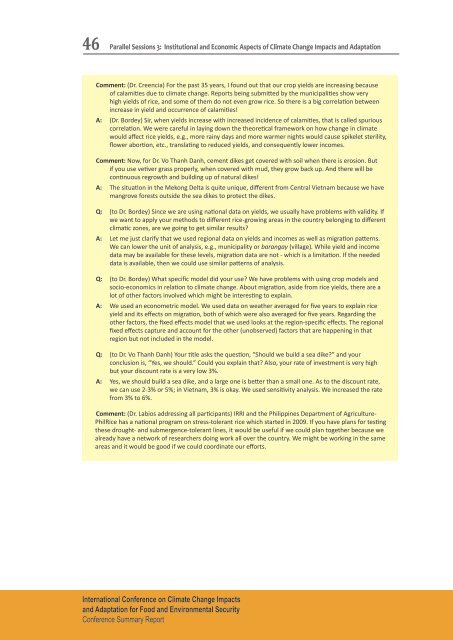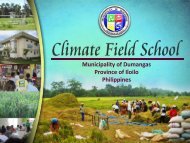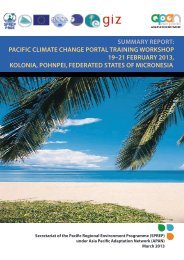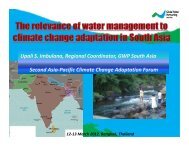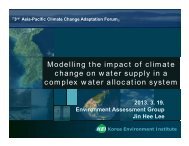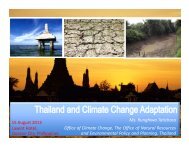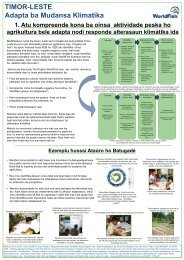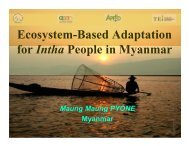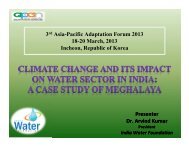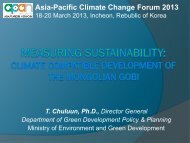PDF file (2.44 MB) - Asia Pacific Adaptation Network
PDF file (2.44 MB) - Asia Pacific Adaptation Network
PDF file (2.44 MB) - Asia Pacific Adaptation Network
You also want an ePaper? Increase the reach of your titles
YUMPU automatically turns print PDFs into web optimized ePapers that Google loves.
46Parallel Sessions 3: Institutional and Economic Aspects of Climate Change Impacts and <strong>Adaptation</strong>Comment: (Dr. Creencia) For the past 35 years, I found out that our crop yields are increasing becauseof calamities due to climate change. Reports being submitted by the municipalities show veryhigh yields of rice, and some of them do not even grow rice. So there is a big correlation betweenincrease in yield and occurrence of calamities!A: (Dr. Bordey) Sir, when yields increase with increased incidence of calamities, that is called spuriouscorrelation. We were careful in laying down the theoretical framework on how change in climatewould affect rice yields, e.g., more rainy days and more warmer nights would cause spikelet sterility,flower abortion, etc., translating to reduced yields, and consequently lower incomes.Comment: Now, for Dr. Vo Thanh Danh, cement dikes get covered with soil when there is erosion. Butif you use vetiver grass properly, when covered with mud, they grow back up. And there will becontinuous regrowth and building up of natural dikes!A: The situation in the Mekong Delta is quite unique, different from Central Vietnam because we havemangrove forests outside the sea dikes to protect the dikes.Q: (to Dr. Bordey) Since we are using national data on yields, we usually have problems with validity. Ifwe want to apply your methods to different rice-growing areas in the country belonging to differentclimatic zones, are we going to get similar results?A: Let me just clarify that we used regional data on yields and incomes as well as migration patterns.We can lower the unit of analysis, e.g., municipality or barangay (village). While yield and incomedata may be available for these levels, migration data are not - which is a limitation. If the neededdata is available, then we could use similar patterns of analysis.Q: (to Dr. Bordey) What specific model did your use? We have problems with using crop models andsocio-economics in relation to climate change. About migration, aside from rice yields, there are alot of other factors involved which might be interesting to explain.A: We used an econometric model. We used data on weather averaged for five years to explain riceyield and its effects on migration, both of which were also averaged for five years. Regarding theother factors, the fixed effects model that we used looks at the region-specific effects. The regionalfixed effects capture and account for the other (unobserved) factors that are happening in thatregion but not included in the model.Q: (to Dr. Vo Thanh Danh) Your title asks the question, “Should we build a sea dike?” and yourconclusion is, “Yes, we should.” Could you explain that? Also, your rate of investment is very highbut your discount rate is a very low 3%.A: Yes, we should build a sea dike, and a large one is better than a small one. As to the discount rate,we can use 2-3% or 5%; in Vietnam, 3% is okay. We used sensitivity analysis. We increased the ratefrom 3% to 6%.Comment: (Dr. Labios addressing all participants) IRRI and the Philippines Department of Agriculture-PhilRice has a national program on stress-tolerant rice which started in 2009. If you have plans for testingthese drought- and submergence-tolerant lines, it would be useful if we could plan together because wealready have a network of researchers doing work all over the country. We might be working in the sameareas and it would be good if we could coordinate our efforts.International Conference on Climate Change Impactsand <strong>Adaptation</strong> for Food and Environmental SecurityConference Summary Report


